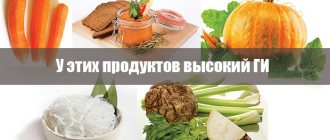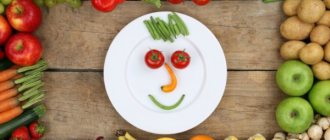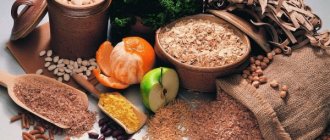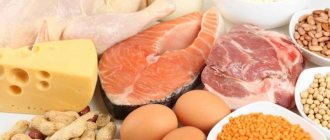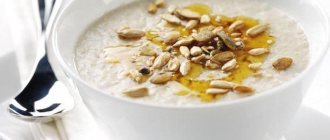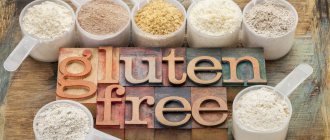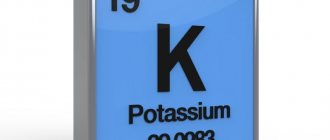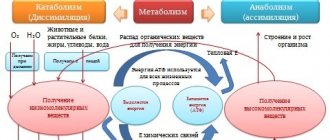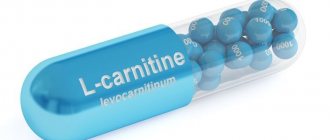Almost all major food pyramids contain cereals at the base. For some it is rye and wheat, for others it is rice and corn. But are all cereals as healthy as they are commonly thought to be? Nutritionists say no. What grains should Russians exclude from their diet or eat extremely rarely? And what kind of cereal should you have for breakfast if you don’t want to gain weight?
The main problem of everyone who is getting plump before their eyes or can’t lose extra pounds is overeating. A constant feeling of hunger forces you to snack often and little by little. But what doctors recommend “often” turns into “continuously,” and “little by little” is too relative a concept. It turns out that you need to eat less. But how? Is it possible, given the cereal base of the food pyramid, to achieve the desired slimness?
Cereals are healthy, but not all of them. Having instant oatmeal for breakfast, snacking on a muesli bar, having buckwheat flakes as a side dish for lunch and sushi for dinner - it’s unlikely that such a set will help you maintain a beautiful figure, much less lose weight. But what about the benefits of cereals?
For cereal to be healthy, it must be whole. Buckwheat, brown and red (preferably black) rice, whole oats (can be rolled), millet, pearl barley - all these cereals and side dishes help you lose weight only if they are not put into a quickly digestible form, that is:
- — not peeled until white (white rice);
- - not into flour (any wheat, rye, rice and buckwheat flour);
- - not flattened into instant cereal (Hercules oatmeal, multigrain flakes, etc.;
- - not mixed with sugar and sweet syrups (muesli and bars).
Glycemic index of various types and forms of cereals
Cereals are 80% carbohydrates, which are broken down into glucose and serve as fuel for humans. But the faster the breakdown occurs, the higher the glycemic index of the product. This means that the faster the body receives energy, but, alas, the faster it requires food again. Any product with a high glycemic index is a great way to instantly restore strength (for example, after an intense workout or exhausting physical labor). But such food is not suitable as a constant food, especially for a person sitting at a computer.
- Sushi rice – 90
- Parboiled white rice – 85
- Instant oatmeal - 69-83
- Millet - 70
- Muesli – 70
- White unparboiled rice – 70
- Semolina – 65
- Couscous – 65
- Red rice – 55
- Long-cooking oatmeal – 55
- Brown (brown) rice – 50
- Millet groats – 50
- Buckwheat – 50
- Wild (black) rice – 35
- Quinoa – 35
- Pearl barley – 22
The glycemic index of cereals is not always constant. When cooked, the glycemic index of porridge or cereal side dish increases. The longer buckwheat is cooked, the more it boils, the faster it is absorbed, the faster the level in the blood increases.
By adding a little butter to porridge or brown rice, combining morning oatmeal with a piece of cheese, and lunch millet with chicken breast, you lower the glycemic index of the cereal. When entering the body along with protein or fats, quickly digestible carbohydrates begin to break down more slowly.
The benefits of buckwheat
Sugar level
The benefits of buckwheat cannot be assessed. All this is due to the content of many vitamins and microelements in it. Buckwheat porridge ranks first in terms of iron content compared to other cereals. Thanks to the daily consumption of such porridge, a person reduces the risk of developing anemia and low hemoglobin.
Foods with a high glycemic index will first raise your blood sugar levels. But in order for your body to work well, this indicator must be constant. The human body produces a hormone called insulin, whose role is to lower blood sugar levels. The higher the blood glucose level, the more insulin production is strong and can cause the opposite situation: this is called a hypoglycemia reaction.
If, for example, at breakfast you eat croissants, sugary industrial drinks, spreads filled with refined sugars, you will have a serious chance of having a bar and cravings for sweets in the middle of the morning! and if you give in to your impulses, the cycle can repeat itself all day long. In addition to this, you should know that insulin causes fat storage. The more you produce, the more likely you are to gain weight. Here are 4 tips we have prepared for you.
In addition, only buckwheat contains flavonoids (vitamin P), which increase the elasticity of the walls of blood vessels and prevent bleeding. Vitamin C is absorbed by the body only in the presence of flavonoids.
Potassium lowers blood pressure, since its main role is the synthesis of proteins and glycogen, normalization of water balance in cells. Calcium strengthens nails, bones and teeth. Magnesium, interacting with insulin, increases its secretion and cell sensitivity.
To prevent the risk of hypoglycemia, eat foods with a low glycemic index, such as whole grains, legumes, vegetables and fruits. These foods will have a low impact on your blood sugar and are high in fiber, which will make you feel full quickly!
This principle starts with breakfast. If you miss this meal, your body will take revenge by making up for this lack of energy during the day because you are coming out of a young night during which your body has not received food and therefore energy for several hours.
A little emptiness in the day? Pack a snack or two for work or while traveling. By planning your snacks, you'll avoid hacking foods that are faster and worse for your health, like candy bars. So, be sure to pack fresh fruits and oil seeds to keep your body nourished and filled with essential micronutrients.
In general, buckwheat contains the following beneficial vitamins and microelements:
- vitamin A;
- B vitamins;
- vitamin E;
- flavonoids;
- potassium;
- calcium;
- magnesium;
- iron.
Buckwheat porridge in the daily diet of type 1 and type 2 diabetics will provide the body with all the necessary vitamins and microelements.
If you can't finish a meal without a sweet taste, give yourself a few squares of dark chocolate for dessert or snack. Being able to enjoy yourself every now and then is also one of the keys to long-term success and well-being! During sleep, the body naturally relies on reserves. To bring fuel when you wake up and replenish your energy, you'll need a carbohydrate-rich breakfast. But not only carbohydrates, we prefer those with a low glycemic index. Avoid the blood sugar peak and expect cravings in the morning.
The harm of oatmeal for breakfast
If you carefully studied the numbers above, you will notice that large oat flakes, which require a long cooking time, have a significantly lower glycemic index than Minutka. If you eat oatmeal, as numerous articles recommend, what kind? And how do you prepare them?
Instant oatmeal from bags, especially with sugar and dried fruits, is close to pure sugar in terms of harmfulness, their glycemic index will be at least 90. But you can reduce the already low glycemic index of oat flakes (whole rolled oats) if you do not cook them .
Pour boiling water over three tablespoons of oatmeal and cover with a lid. In 7-10 minutes you will have the basis of a great breakfast. Add a tablespoon of olive oil and a fresh apple to the porridge. Cut a piece of cheese or take a boiled egg for a snack. After such a breakfast, you won’t feel hungry for a long time, which means that when you arrive at work, you won’t grab cookies and pour yourself traditional coffee.
Not all rice is equally healthy
“The Japanese lose weight because they eat a lot of rice.” A fatal misconception for Westerners. The Japanese do not eat a lot of rice, but their diet consists of a large amount of vegetables and herbs, fish, and for dessert they take fresh fruits rather than dried fruits and sweets. Try eating white rice every day and maintain a thin waist, firm hips and health.
White rice has a very high glycemic index, and therefore is not at all suitable for everyday nutrition. Treat it like cake and treat yourself to fluffy rice or sushi only on holidays. In ordinary life, you should have brown rice in your cupboard, preferably mixed with wild rice. We won’t recommend only the wild one: it’s not cheap, and the taste is not for everyone.
Brown rice also needs to be cooked correctly. It is best to use a double boiler, rice cooker or multicooker, i.e., so that the cooking time is reduced to a minimum. This way, the maximum of useful components will remain in the rice, and its glycemic index will not increase.
Healthy recipes
If you have diabetes, it is better to cook any cereal, including buckwheat, in water, without adding butter. If you decide to cook porridge with milk, then it is better to stick to the proportions of one to one, that is, mix milk and water in equal quantities.
You can also prepare complex side dishes from buckwheat, for example, by stewing it with mushrooms, vegetables, meat or offal (liver, beef tongue).
Additionally, carbohydrates with a low glycemic index indicate destruction and deoxidation. Expert tip: whole bread, not whole bread, preferably organic. A side amount, 2 or 3 slices of bread makes a good base of carbohydrates.
For Libra maniacs, you don't need to eat plain bread. It can be rich without weighing with pure almond puree without added sugar or jam without added sugar in a thin layer. For salted beaks, you can also cook raw ham, smoked salmon, smoked trout or hard cheese, which will keep you feeling full.
Buckwheat is used not only as side dishes, but also to create flour dishes. Buckwheat flour makes baked goods quite tasty and unusual in taste. Pancakes are also made from it.
You can prepare the following dishes from buckwheat:
- boiled porridge with water or milk;
- buckwheat with mushrooms;
- buckwheat with vegetables;
- various buckwheat pastries.
The recipe for buckwheat pancakes is quite simple to prepare. The following ingredients will be required:
A healthy breakfast consists of whole fruit. High in calories and low in calories, fruits provide fiber, vitamins and antioxidants. We use the whole fruit and the season is better. And we avoid grapefruit as much as possible, which is too inflammatory. Finally, for those who have problems with fermentation or bloating, fruit can be taken later, after meals.
Breakfast for weight loss without lactose. While coffee and tea are the basis for a good start to the day, decaffeinated drinks are also good because they are easier to digest. To maintain or restore a flat stomach, you can reduce or eliminate dairy products, which are insulinogenic, that is, they stimulate insulin secretion. It's not heresy that we find calcium in many foods. You can easily skip the glass of milk and substitute a glass of plant-based milk or soy milk yogurt with a dash of agave syrup, coconut sugar or xylitol.
- one egg;
- crumbly cottage cheese – 100 grams;
- baking powder – 0.5 teaspoon;
- stevia – 2 sachets;
- boiling water – 300 ml;
- vegetable oil – 1.5 tablespoons;
- salt - on the tip of the knife;
- buckwheat flour – 200 grams.
To begin with, you should pour boiling water over the filter bags of stevia and leave for 15–20 minutes, cool the water and use it for cooking. Separately mix stevia, cottage cheese and egg. Sift the flour through a sieve and mix with salt and baking powder, pour in the curd mixture, add vegetable oil. Fry without adding oil, preferably in a Teflon-coated pan.
Pinot Pizzas Pizzas are made using dough, in addition to water, salt and a small amount of soft wheat, essential to create the core of the dough and a natural fermentation, a mixture of whole wheat flour. Thus, a dough consisting of an amount of dietary fiber far superior to that found in a common pizza, with many benefits we're talking about an anti-hunger effect for an early feeling of fullness and a significant slowdown in the absorption of carbohydrates.
As we know, this cannot be obtained by consuming pizza made from traditional dough, which makes extensive use of a “refined” product such as flour. We see in more detail that wholemeal flour is different from traditional white flour.
You can make buckwheat pancakes with berry filling. The second recipe is identical to the first, only at the last stage of kneading the dough you need to add berries. For diabetes, the following are allowed:
- black and red currants;
- blueberry.
An equally popular baked product for type 2 diabetics is buckwheat cookies. It can be consumed for breakfast, or as an addition to lunch. Just take into account how much XE is contained in such cookies. This pastry contains only 0.5 XE per 100 gram serving.
One of the main differences between the nutritional values of whole wheat flour and white flour is the fiber content, which is much higher in whole wheat flour. Dietary fiber comes from the part of the plant that is not digested by enzymes in the intestinal tract. Without being digested by the body, it has no nutritional value for humans. Although dietary fiber is not considered nutritious, it has functional and metabolic effects that make it an important component of the human diet.
Dietary fiber has a number of health benefits - it prevents constipation, lowers blood cholesterol and helps with weight loss. Different types of plants vary in the amount and type of fiber. Dietary fibers, including pectin, gums, mucilages, cellulose, hemicellulose, and lignin, fall into two main categories: water-soluble and water-insoluble.
Required:
- sweetener - to taste;
- buckwheat flour – 250 grams;
- egg – 1 pc.;
- low-fat margarine – 150 grams;
- cinnamon - to taste;
- salt on the tip of a knife.
Mix soft margarine with egg, salt and sweetener, mix everything thoroughly. Add flour in parts, knead into a tight dough. Roll out the dough and form cookies. Bake in a preheated oven at 180 C for 25 minutes.
Pectin, mucilage and gum are soluble fibers found in plant cells. Highly hydrating, they increase the viscosity of intestinal contents and have prebiotic activity, meaning they can stimulate the growth of certain types of beneficial bacteria to maintain proper intestinal function. They also lower cholesterol and may help reduce glucose levels in the bloodstream. Legumes, oats, pearl barley, oat bran, dried fruits and apples, citrus fruits, carrots and plantain contain water-soluble fiber.
This type of baking is suitable for any type of diabetes and will not affect blood sugar levels.
What is there?
Buckwheat, quinoa, millet, a mixture of wild and brown rice, pearl barley - all these grains, if not flattened into flakes and ground into flour, will help you feel full for a long time and not gain weight.
To lower the glycemic index of a dish, eat any cereal side dishes and cereals along with some healthy fats and protein.
According to Montignac, all foods are divided into “bad” and “good” - depending on the GI value. The bad ones have a higher index level and are able to raise blood sugar levels in a very short time.
If for an ordinary person this is painless, then for a person suffering from diabetes, a sweet bun or mashed potatoes can cause a significant deterioration in well-being. To prevent this from happening, you need to at least approximately know the GI indicators of the most basic food products. We will not talk in detail about all products, we will focus only on cereals.
Glycemic index of oatmeal with water
This porridge has a lower GI level, and it is 40
, you will agree that it is much lower. It follows from this that this product can be classified as low GI
IMPORTANT!!! But everyone’s favorite “Muesli” has a high BG - 80 units. This is due to the presence of nuts and dried fruits in them. So if you decide to lose weight or maintain normal blood sugar levels, keep this delicious product out of sight.
Knowing the beneficial properties and level of the glycemic index can help in creating a competent diet that promotes weight loss, normalizing blood sugar levels and improving the health of the body.
determines the extent to which a particular food increases blood sugar levels and determines the insulin response of the pancreas. The lower the glycemic index, the more often you should eat such foods. The higher the glycemic index, the less often you include these foods in your diet. Low glycemic index
: 10-35.
Average glycemic index
35-50.
High glycemic index
: over 50.
Overall rating
This is an indicator based on a combination of the following factors:
calorie content
,
glycemic index
,
protein, fat and carbohydrate content
. Each product is rated on a scale from 0 to 10 and determines how much a particular product is recommended to be consumed during a weight loss program. The overall rating is not related to the “absolute benefit” of a product, but only indicates how much the product helps or hinders. The higher the overall score, the more often it is recommended to consume such products; the lower, the less often.
The story with cereals is as follows: in their dry form, we, of course, will not chew them, but heat treatment, that is, cooking, significantly increases both the calorie content and the glycemic index. But in porridge cooked in water, the glycemic index does not increase by much at all. If we add milk and butter, this is already a significant calorie content of the product. And even more significant - these are store-bought instant porridges! This is generally a fat bomb due to the addition of sugar and the type of industrial processing. However, we need porridge, because it is healthy and satiates us very well. But, if we want to lose weight, then we only need porridge with water, without sugar and salt, and nothing else. To make it less boring (although after a week you get used to it and feel the full bouquet of taste of the porridge), you can add vegetables or mushrooms.
| Product name | Food | value | (per 100 gr.) | Overall rating | ||
| GI | kcal | Squirrels | Fats | Carbohydrates | ||
| Rye bran | 15 | 155 | 15 | 3,5 | 15,5 | 10 |
| Wheat bran | 25 | 212 | 15 | 3,5 | 30 | 10 |
| Buckwheat | 25 | 308 | 12,6 | 3,3 | 57,1 | 9 |
| Buckwheat porridge on water | 40 | 92 | 3,4 | 0,7 | 20 | 10 |
| Buckwheat porridge with milk | 60 | 201 | 9,5 | 2,9 | 34,8 | 6 |
| Pearl barley | 25 | 320 | 9,3 | 1,1 | 73,7 | 9 |
| Pearl barley porridge on water | 45 | 106 | 3,1 | 0,4 | 23 | 10 |
| Pearl barley porridge with milk | 75 | 135 | 4 | 0,6 | 31 | 6 |
| Oat groats | 30 | 342 | 12,3 | 6,1 | 59,5 | 9 |
| Oatmeal on water | 40 | 88 | 3 | 1,7 | 15 | 10 |
| Oatmeal cereal | 55 | 92 | 3,1 | 1,5 | 17 | 6 |
| Oatmeal with milk | 80 | 102 | 3,2 | 4,1 | 16 | 6 |
| Muesli | 85 | 248 | 6,9 | 5,8 | 44,1 | 2 |
| Millet | 50 | 353 | 11 | 3 | 69 | 9 |
| Millet porridge on water | 50 | 120 | 4,5 | 1,5 | 20 | 10 |
| Millet porridge with milk | 70 | 145 | 4,2 | 2,5 | 27 | 6 |
| Sprouted wheat | 15 | 198 | 7,5 | 1,3 | 41,5 | 10 |
| Wheat groats | 50 | 304 | 13 | 2,5 | 57,5 | 8 |
| Wheat porridge on water | 70 | 91 | 3 | 0,5 | 18,8 | 9 |
| Wheat porridge with milk | 95 | 198 | 4,6 | 1,5 | 26,9 | 6 |
| Semolina | 60 | 333 | 10,3 | 1 | 70,6 | 8 |
| Semolina porridge on water | 75 | 98 | 2,5 | 0,2 | 15,3 | 7 |
| Semolina porridge with milk | 98 | 120 | 3 | 3,2 | 16,8 | 6 |
| White rice | 75 | 374 | 8 | 1 | 78,2 | 2 |
| Boiled white rice | 85 | 116 | 2,2 | 0,5 | 24,9 | 3 |
| Brown rice | 45 | 362 | 7,5 | 2,7 | 72,8 | 8 |
| Boiled brown rice | 50 | 110 | 2,6 | 0,9 | 22,8 | 10 |
| Wild black rice | 45 | 101 | 4 | 0,4 | 21,3 | 10 |
| Boiled wild black rice | 50 | 100 | 4 | 0,3 | 21 | 10 |
| Chickpeas | 30 | 329 | 20 | 4,3 | 46 | 8 |
| Canned chickpeas | 40 | 364 | 19 | 9 | 56 | 6 |
| Mung bean peas | 25 | 308 | 24 | 1,4 | 52,7 | 8 |
| Quinoa cereal | 35 | 368 | 14,2 | 6,1 | 57,2 | 8 |
| Amaranth groats | 40 | 371 | 13,6 | 7 | 69 | 8 |
| Potato flakes | 95 | 369 | 7 | 1 | 83 | 2 |
| Corn grits | 328 | 6 | 1,2 | 71 | 2 | |
| Canned corn | 60 | 58 | 2,2 | 0,4 | 11,2 | 6 |
| Corn porridge | 66 | 86 | 0 | 0,2 | 20 | 5 |
| Cornflakes | 85 | 326 | 8,3 | 1,2 | 75 | 2 |
| Almond flour | 30 | 602 | 25,9 | 55 | 4 | 5 |
| Lentils | 25 | 328 | 25 | 1,1 | 53 | 8 |
| Lentils boiled in water | 30 | 110 | 8 | 0 | 20 | 10 |
| Dry peas | 25 | 314 | 23 | 1,6 | 50 | 6 |
| Peas (canned) | 45 | 40 | 3,1 | 0 | 6,5 | 6 |
| Pea porridge | 25 | 99 | 7,7 | 0,5 | 19,3 | 8 |
| Beans | 35 | 292 | 21 | 2 | 46 | 8 |
| Beans, boiled | 30 | 125 | 7,8 | 0,5 | 21,5 | 9 |
| Beans, canned | 59 | 99 | 6,7 | 0 | 16 | 5 |
Low-calorie diets that contain buckwheat porridge are now in fashion not only because of girls trying to lose weight, but also because the number of people with diabetes mellitus (DM) has increased. Every year there are only more and more diabetics, but a cure for this disease has not yet been created.
The main problem of people with diabetes is the lack or poor perception of insulin produced by the pancreas, which is responsible for transporting glucose from the blood to the body's cells. Due to the fact that there is not enough hormone, the concentration of sugar increases and the person’s blood vessels begin to collapse. At the same time, creating a new menu to normalize sugar levels is not so simple, because you need to know not only the number of calories in a certain product, but also its . This indicator is responsible for the degree of digestion of food and has a scale from 0 to 100, where 100 is the GI of glucose.
It is divided into 3 types, namely low (up to 39), medium (up to 69) and high (70 and above). At the same time, when eating food with a GI of up to 70, a person remains full much longer, and the concentration of sugar in the body does not particularly increase. When consumed, a person gains quick energy and if the resulting strength is not used in time, it will settle as fat. In addition, such food does not saturate the body and greatly increases blood glucose levels and insulin production.
It is worth noting that nutritionists recommend adding porridge to your diet, for example, wheat and barley, as well as buckwheat, rice, pearl barley and oatmeal (rolled oats), because each of them has a small glycemic index. Due to this, they take longer to digest and the feeling of fullness will not go away soon. Semolina and corn porridge should be especially noted, since their glycemic index is 60-70, therefore, they should be consumed with caution.
In addition to being useful for diabetes and for weight loss, cereals are useful for athletes during the period of drying out the body, since they need food that contains a lot of slow carbohydrates with a low glycemic index and a meager amount of calories.
Calorie content and consumption standards
The most dietary recipe is barley cooked in water. If you cook it with butter and milk, it becomes more nutritious, and if you cook it with vegetables, it becomes less nutritious. The caloric content of the product per 100 grams is as follows:
- dry pearl barley – 315 kcal;
- pearl barley porridge cooked in milk – 156;
- pearl barley cooked in water – 109;
- porridge with butter and milk – 178;
- porridge in water with added butter – 131;
- pearl barley porridge with boiled pumpkin – 63.
It should be noted that low-calorie cereals are filling and nutritious; just two spoons of porridge allow people not to feel hungry for a long time.
Nutritionists say that for an adult, the daily intake of pearl barley porridge is 150 grams.
GI indicators of cereals
A key part of any diet is the presence in the daily menu of cereals with a low and medium glycemic index, because the cereals from which they are prepared contain many substances beneficial to the human body.
At the same time, you can study the glycemic index of various types of cereals using this table:
There is a popular rule that the larger the grain, the lower its GI. In fact, this fact is most often justified, but much depends on the method of preparing the porridge and you can see the differences in the glycemic index in this table:
Pickle soup with barley: classic recipe
A very rich and at the same time light soup, its taste benefits greatly from the addition of pearl barley. The kitchen should have:
- beef (500 grams);
- water (2.5 liters);
- crumbly cooked pearl barley (two tablespoons);
- cucumber pickle (300 g);
- potatoes (400 g);
- pickled cucumbers (150 g);
- one carrot;
- one onion;
- sunflower oil (tablespoon);
- two bay leaves;
- black pepper, dill, salt.
To prepare a delicious pickle, you need to cook beef broth, as soon as it is ready, add potatoes, cook for another ten minutes, then add boiled pearl barley, it is advisable to cook it in advance. Then fry the dressing in oil (carrots, onions and cucumbers) and add to the soup. Add brine, put pepper and bay leaf in the pan. As soon as the potatoes are ready, you need to chop the dill into the soup and let it brew. It is impossible to break the diet, since pickle with barley has only 38 kcal per 100 grams.
The glycemic index of pickle with barley is low, and this is wonderful. It is approximately 37.5 units per serving.
Buckwheat
As for the GI of porridge like buckwheat, it ranges from 50 to 60. According to doctors, it is recommended to eat it every day to reduce the concentration of glucose and cholesterol in the blood. This effect is achieved thanks to the composition of the cereal, because it contains many vitamins, especially group B, microelements (calcium, iodine, iron), amino acids (lysine and arginine) and antioxidants. In addition, it contains proteins that are beneficial to the body and improve metabolism.
It is worth noting the glycemic index of boiled buckwheat, because due to water the indicator becomes lower and equals 40-50. In addition, among all porridges, buckwheat is the leader in the amount of useful active substances in its composition.
Contraindications to the use of pearl barley
Due to the gluten contained in pearl barley, its excessive consumption is undesirable for pregnant women.
If people suffer from constipation, gastrointestinal diseases, etc., they should not overuse pearl barley porridge, as it promotes excessive gas formation.
Barley can be dangerous for men in the sense that it can reduce libido if consumed in excess.
The amino acids contained in the cereal can cause an allergic reaction.
Most of the nutrients in the finished pearl barley dish disappear during the cooling process. That is why nutritionists advise eating it hot.
Millet
Millet is a fairly common type of cereal, and it has an average glycemic index, which ranges from 40 to 60, depending on the processing method and the amount of water during cooking. After all, the more liquid there is, the lower the GI will be. This cereal is good for cardiovascular diseases and problems with excess weight. In addition to these positive effects and a suitable glycemic index, millet porridge contains substances to stimulate the growth and development of children.
Corn
Despite the abundance of vitamins and microelements in corn, not everyone can consume it and only in small portions. For such a reason as the high glycemic index, because corn grits have 70 units. In addition, if it is further processed, for example, thermally or chemically, then the GI will increase even more, because in the same corn flakes and popcorn it reaches 85. For this reason, corn products can be consumed, but in small quantities and preferably for non-diabetics .
What and how can you treat with pearl barley?
The list of disorders that can be treated thanks to pearl barley turned out to be quite impressive:
- Positively affects the nervous system.
- Lysine contained in pearl barley improves the production of collagen in the human body, which has a positive effect on the skin and makes it elastic and smooth.
- Pearl barley helps strengthen bone tissue.
- For many different diseases, a decoction of pearl barley can be used. It has anti-inflammatory, enveloping, analgesic, emollient, antispasmodic and diuretic effects.
- With the help of pearl barley, coughs and colds, obesity and constipation, as well as various pathologies of the mammary glands are treated.
Hercules
The glycemic index of oatmeal is 55 units, which is an average value acceptable even for diabetes.
This porridge contains many useful substances that allow you to produce serotonin (the hormone of happiness), control blood sugar levels and strengthen the body as a whole.
For this reason, they are added to their diet not only by diabetics, but also by many healthy people who want to tidy up their digestive system and figure.
The most common types of Hercules are:
- Instant porridge. They are produced in the form of flakes and differ from regular oatmeal in that they are pre-treated with steam so that they can then be cooked in a matter of minutes;
- Crushed oats. This porridge is sold in the form of crushed grains and usually takes at least 20-30 minutes to prepare;
- Oat groats. Sold in whole form and takes the longest to cook (40 minutes);
- Oatmeal (rolled oats). Unlike instant porridge, they are not thermally processed, so they take about 20 minutes to cook.
Additional features
Barley and cereals prepared on its basis are actively used in the field of traditional medicine. This is explained, for example, by the fact that a decoction based on them is characterized not only by a softening or enveloping effect, but also by antispasmodic and anti-inflammatory effects. We should not forget about the general strengthening properties, which will be useful for anyone who has been diagnosed with type 1 or type 2 diabetes.
Barley is also used in the treatment of this disease because it makes it possible to combat impaired vision, kidney, liver or gall bladder diseases. The presented product will be no less useful if it is necessary to restore the optimal condition of the urinary tract and for ailments of the entire gastrointestinal tract system.
A decoction prepared from barley is characterized by various positive effects on the general condition of the body. In addition, it is with the help of barley that it is possible to treat pathological conditions associated with the mammary gland, as well as get rid of constipation or obesity. If the body is in normal condition, treatment of coughs and colds is possible.
DIABETES IS NOT A VERDICT! Myasnikov told the whole truth about diabetes! Diabetes will go away forever in 10 days if you drink in the morning... »read more >>>
I would also like to draw attention to the fact that the presented diabetic product can also be used as a general tonic. This is carried out in the period after surgery for inflammatory diseases of the stomach or intestines
Thus, eating barley in the form of porridge and other food products is more than acceptable. However, it is strongly recommended to first consult with a specialist and familiarize yourself with the list of main contraindications and restrictions.
ul
Wheat
Wheat cereal has long been known for its concentration of fiber, which prevents the formation of fat by regulating blood glucose levels. In addition, it contains pectins, which prevent rotting from starting and improve the general condition of the mucous membrane of the gastrointestinal tract. As for the glycemic index, wheat cereal has an index of 45.
When compiling a diet, you should always focus on the glycemic index of cereals, since many processes, including digestion, depend on it, and for some diseases this indicator is key.
Features of oatmeal and its properties
Why is oatmeal recommended to all segments of the population? It's simple: everyone will find special benefits in it.
For men
Zinc contained in oatmeal is necessary for men to prevent genitourinary problems and diseases. And fiber and protein are a source of physical strength. Of course, someone will say that meat contains more of these elements, but steak for breakfast is inappropriate. But a bowl of oatmeal is nutritious, satisfying and healthy. Only the flakes should be coarsely ground: it is not without reason that they are named after the Greek strongman Hercules.
For women
In addition to the microelements and vitamins listed above, oatmeal also contains antioxidants. They fight toxins, removing them from the body. And if you eat oatmeal for breakfast for at least a month, you will notice how the skin on your face becomes smoother, pimples and blackheads go away. Oatmeal also contains tocopherol (vitamin E), which is necessary for beautiful skin and hair.
Some women also use oatmeal for external use. They wash themselves with oatmeal water and make a scrub from ground flakes. This has a beneficial effect on the condition of the facial skin.
For pregnant
B vitamins, folic acid, iron - these elements are necessary for a woman during pregnancy. And almost half of the daily requirement of these substances is found in oatmeal. And fiber will help avoid constipation, which often affects expectant mothers. But we remember that you cannot eat more than one small bowl of porridge per day. Otherwise, phytin will accumulate in the mother’s body and begin to wash away calcium, which is important for the baby.
For those losing weight
We have already talked about the dietary properties of coarse oatmeal. These are complex carbohydrates that keep you feeling full for a long time, but do not contribute to weight gain. So oatmeal with water and without additives is an ideal breakfast for those who are on a diet. But the oatmeal mono-diet is harmful.
For people suffering from gastrointestinal diseases
Oatmeal is a godsend for a body depleted by gastritis or other diseases of the gastrointestinal tract. There is no other dish that has all the necessary properties:
- viscous, envelops the walls of the stomach;
- neutralizes increased acidity of gastric juice;
- Gives a sick person strength, saturates the body with useful substances.
People with acute gastrointestinal diseases usually have poor appetite due to stomach discomfort. But oatmeal with water is very easy to eat - it has almost no taste, so it does not increase nausea. As a last resort, you can make oatmeal jelly from flakes ground into dust.
